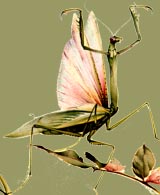 |
 back back   next next
Insects and Biodiversity
Insects and People
Insect Characteristics
|
|




INSECT CHARACTERISTICS
SENSES
Touch, taste, see, hear and smell
There are certain insects that can smell with their antennae, taste with their feet and hear with special organs in their abdomen, front legs or antennae. Taste organs however, are mostly located on the mouthparts and the organs of smell are primarily on the antennae. Most insects have compound eyes which are composed of many independent visuals units, called ommatidia. Often there are thousands of these units and the individual images formed by them combine in the insect's brain to create a picture of the world.
Sensory hairs, which are linked to nerve cells, are widely distributed over their bodies but particularly abundant on the antennae and legs. These hairs are sensitive to touch and in some groups detect sound waves. Tympanal organs in grasshoppers, crickets, cicadas and moths also detect sound. These organs are paired structures composed of a thin membrane, the tympanum. The detection of sound is important for protection and communication.
Insects also communicate by means of chemicals or mixtures of chemicals called pheromones. These compounds are active in very small amounts and convey a variety of messages to other individuals. These messages include attraction and recognition for mating and marking trails for members of the same species.

The arrow in the above photo points to a grasshopper's ear, which appears to be near his knee.
 Back to top
Back to top
|